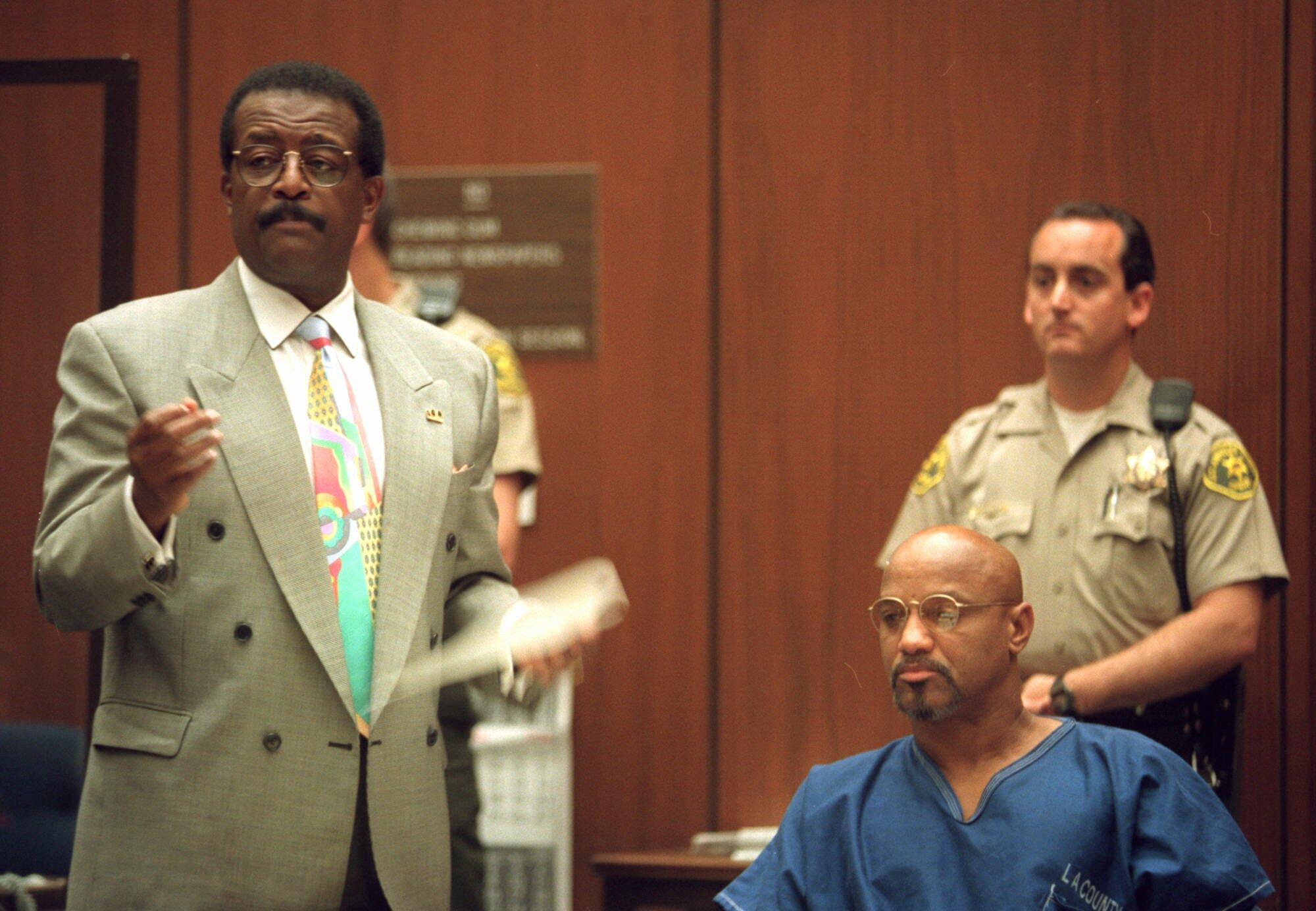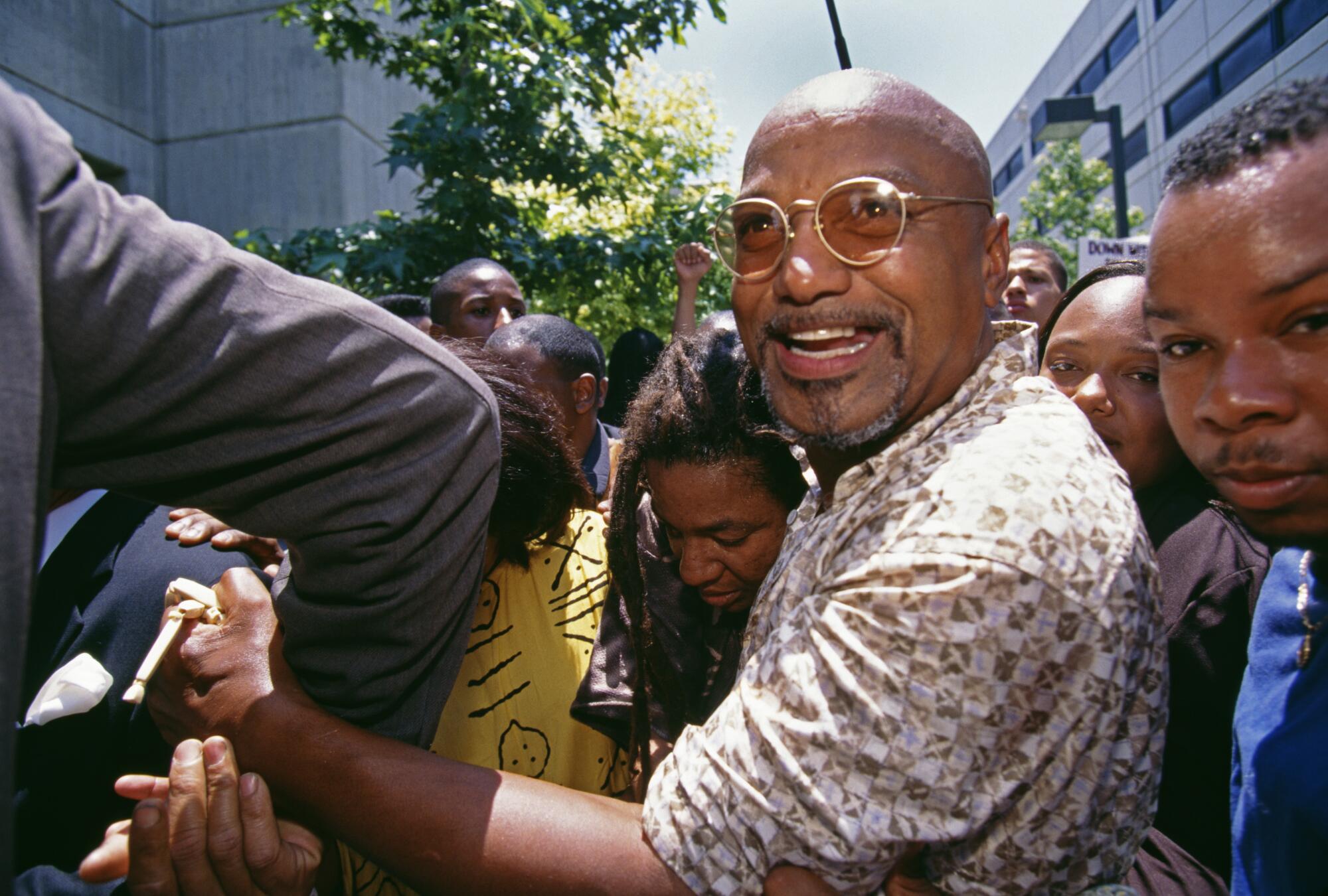He was an uncommonly harmful man, within the FBI’s eyes, a combat-toughened killer who had returned from Vietnam to wage struggle on the Institution.
“We are going to drive the pigs out of the community,” Elmer “Geronimo” Pratt, the 21-year-old chief of the Black Panther Social gathering in Los Angeles, informed a reporter in 1970.
Pratt was stout, compact and level-eyed, with a raspy drawl bespeaking his childhood on the Louisiana bayou. He envisioned a violent finish by the hands of police, whom he solid as an occupying military in African American neighborhoods. “The next time you see me, I might be dead.”
When he went on trial in 1972 — on expenses he murdered a white schoolteacher, execution-style, throughout a theft — he insisted he was being framed.
His protection lawyer, a younger Johnnie Cochran Jr., initially dismissed Pratt’s discuss as paranoia. However Cochran would later describe the case as “a twilight zone of deceit, dishonesty, betrayal and official corruption.”
Pratt’s conviction stored him behind bars for 27 years, and the case haunted Cochran, who believed Pratt was harmless and who had made a mistake at trial that prosecutors skillfully exploited. Within the authorities’ struggle in opposition to perceived subversives, it might be years earlier than it turned clear how overtly they’d cheated.

Lawyer Johnnie Cochran, left, would describe Pratt’s homicide prosecution as “a twilight zone of deceit, dishonesty, betrayal and official corruption.”
(Jim Ruymen / Pool photograph)
“It looked on the surface like a really straightforward murder case,” mentioned Stuart Hanlon, now 76, the novel San Francisco protection lawyer who took up Pratt’s enchantment as a legislation pupil and pursued it doggedly for many years.
The sufferer was Caroline Olsen, 27, who was together with her husband on a Santa Monica tennis courtroom in December 1968 when a pair of gunmen approached demanding cash. The boys ordered the couple to lie face down, then started opening fireplace. She was fatally wounded; her husband was struck however survived. The robbers received $18.
The investigation stalled, and Pratt was not a suspect till 1970, when Julius “Julio” Butler, a beautician and former police officer, implicated him. Butler had been a Panther himself, and had resented Pratt’s elevation as Los Angeles chief.

On this sequence, Christopher Goffard revisits previous crimes in Los Angeles and past, from the well-known to the forgotten, the consequential to the obscure, diving into archives and the reminiscences of those that had been there.
The state’s star witness, Butler testified that Pratt had dropped by his magnificence store and introduced he was occurring a “mission” and later pointed to an article concerning the Santa Monica capturing to verify it was his doing.
Cochran requested Butler if he had ever been a police informant. Butler flatly denied it.
Devastatingly for the protection, Olsen’s widower pointed to the defendant and mentioned: “That’s the man who murdered my wife.”
Cochran argued in opposition to the reliability of cross-racial witness identification, notably beneath circumstances of stress, and placed on the stand a witness who had seen Pratt within the Bay Space across the time of the killing. He additionally placed on Pratt, who had been adorned for heroism throughout two excursions in Vietnam with the Military, and who confirmed what Cochran known as a “soldier’s contempt” for whomever shot the helpless Olsen within the again.

At a 1996 information convention in Los Angeles, Cochran and different attorneys name for a brand new trial for Pratt.
(Nick Ut / Related Press)
Cochran thought it was a winnable case, however he launched an exhibit that backfired terribly. It was a Polaroid, given to him by Pratt’s brother, who insisted it had been taken per week after the capturing. It confirmed Pratt with a beard, which contradicted the widower’s preliminary description of the shooter as “a clean-shaven black man.”
Prosecutors countered with a Polaroid worker who mentioned the movie had not even been manufactured till 5 months after the crime, a blow to the protection’s credibility that left jurors doubting Pratt’s different claims.
It took jurors 10 days to search out him responsible of first-degree homicide. The sentence was 25 years to life. “You’re wrong. I didn’t kill that woman,” Pratt erupted. “You racist dogs.”
Pratt spent the subsequent eight years in solitary confinement. He was shuttled amongst prisons, and finally allowed conjugal visits; his spouse gave delivery to 2 kids. At a sequence of unsuccessful parole hearings, the panel waited for him to say he was sorry. He insisted he hadn’t accomplished it.
“The last person I killed,” he would say, “was in Vietnam.”

Supporters of Pratt rally for his launch outdoors a Los Angeles courthouse in April 1996.
(Susan Sterner / Related Press)
There was a lot the authorities had not shared with Pratt’s protection workforce. They didn’t reveal that Olsen’s widower had beforehand recognized one other man because the shooter. (The person had been in jail on the time and couldn’t have accomplished it.)
Nor did they reveal the scope of the star witness’ work as an informant for legislation enforcement officers. Primarily based on FBI paperwork obtained by means of the Freedom of Info Act, Pratt’s attorneys pieced collectively an image of Butler’s intimate involvement with the FBI, the Los Angeles Police Division and the L.A. County district lawyer’s workplace in dozens of instances.
To FBI Director J. Edgar Hoover, the Panthers had been probably the most harmful group within the nation, homegrown terrorists with stockpiles of weapons and alarming Maoist rhetoric. His secret COINTELPRO program was a marketing campaign of spying, wiretaps and sabotage geared toward crushing perceived subversives and thwarting “the coalition of militant black nationalist groups.”
“Geronimo was targeted by the FBI because he was a natural leader,” Hanlon mentioned.
As Hanlon pieced collectively paperwork, it turned clear that Butler had been serving to. Rejecting enchantment after enchantment, nonetheless, courts dominated that Butler had not been an informant — he had been “a contact and nothing more,” in response to one decide — and that Pratt didn’t deserve a brand new trial.
He was nonetheless thought of harmful. “If he chooses to set up a revolutionary organization upon his release from prison, it would certainly be easy for him to do so,” a prosecutor mentioned at one parole listening to. “He does have this network out there.”
When protection attorneys introduced their proof to then-L.A. County Dist. Atty. Gil Garcetti in 1993, they offered it as an opportunity to undo the injustice his predecessors had sanctioned 20 years earlier. However Garcetti’s evaluation dragged on for years, and the attorneys turned once more to the courts.

“He was more likely framed than he was the person who actually committed the crime,” former L.A. County Dist. Atty. Gil Garcetti mentioned just lately of Pratt.
(Ken Lubas / Los Angeles Instances)
This time, the courts granted a listening to. As a result of the L.A. County Superior Courtroom bench was recused — the unique prosecutor was now an L.A. County decide and a possible witness — the case was transferred to Orange County Superior Courtroom. For Pratt’s supporters, this provoked a chill. What hope did they’ve in a staunchly conservative county?
However Decide Everett Dickey stunned them.
“It’s clear that this is not a typical case,” Dickey mentioned. “It cries out for resolution.”
This time, Pratt’s workforce was armed with proof by no means heard on the authentic trial. That they had the testimony of a retired FBI agent who supported Pratt’s declare that he had been in Oakland through the killing.
They knew that the D.A.’s workplace had allowed Butler to plead no contest to 4 felonies in change for probation, across the time he testified in opposition to Pratt.
And so they had an index card, just lately found by one in every of Garcetti’s investigators within the workplace information, that listed Butler as a D.A. informant. It was filed beneath B; it had been there all alongside.
“It had never been turned over to the defense. How could they have not turned this over?” Garcetti mentioned in a latest interview. “I couldn’t find anyone who would fess up to the fact that, ‘Yeah, we had that document in the files.’”
Nonetheless, Garcetti’s prosecutors downplayed the cardboard’s significance. Butler was not an informant, they argued vehemently, however merely a “source.”
In late 1996, Cochran lastly received an opportunity to confront Butler. He had waited years. Butler had develop into an lawyer and an official at a outstanding Los Angeles church. He insisted he had been merely a “liaison” between legislation enforcement and the Panthers.
Cochran requested him his definition of informant. He admitted he had informed the FBI that Pratt had a submachine gun. He mentioned his definition of an informant was somebody who provided correct info.
“So under your own definition, you were informing to the FBI?” Cochran requested.
“You could say that,” Butler mentioned.

Pratt beams after his launch from an Orange County jail in June 1997.
(Kim Kulish / Getty Photographs)
Dickey threw out Pratt’s conviction, concluding that Butler had lied and that prosecutors had hidden proof that might have led to Pratt’s acquittal.
Pratt was launched on bail in June 1997, to the cheers of his supporters.
“The greatest moment of my legal career,” Cochran known as it.
Pratt flew dwelling to Morgan Metropolis, La., “to see my mama and my homefolks,” he mentioned. “It wasn’t easy getting here.”
He mentioned he needed to listen to rain on the tin roof of his childhood dwelling.

Pratt’s authorized ordeal was not over, nonetheless. Garcetti appealed, saying he had discovered no proof pointing to Pratt’s innocence. He didn’t drop the case till an appeals courtroom sided with Pratt in February 1999. The next yr, Pratt received $4.5 million in a false-imprisonment lawsuit in opposition to town of L.A. and the FBI. He purchased a farmhouse in Imbaseni, Tanzania, the place he loved the companionship of Pete O’Neal, a former Black Panther who had fled the U.S. in 1970.
O’Neal discovered him useless at dwelling in Might 2011. Pratt had been hospitalized with hypertension, a situation that had plagued him for years, however had torn out his IVs and gone dwelling. He hated confinement. He was 63.
“We always say, ‘The system works,’ but no, the system only produced the right result because Geronimo and the community and a band of lawyers fought the system. The system doesn’t work by itself,” mentioned Mark Rosenbaum, one of many attorneys who helped with Pratt’s enchantment. “They took away half of his life. And they couldn’t break him.”
So, who killed Caroline Olsen? Hanlon believes the killers had been different Black Panthers — a pair of heroin addicts recognized to feed their behavior with armed theft. They died violently within the Nineteen Seventies, one by gunfire, the opposite impaled on a fence throughout a housebreaking.
In a latest interview, Garcetti, one of many protection workforce’s major antagonists for years, mentioned that his views on the case have advanced. Looking back, he regrets preventing to maintain it alive.
“He was more likely framed than he was the person who actually committed the crime,” Garcetti mentioned.
Since leaving workplace, he mentioned, he has discovered extra concerning the U.S. authorities’s techniques in opposition to disfavored teams within the Sixties and ’70s.
“I have read enough to know the FBI, from the top down, were working to isolate any quote-unquote leader in the Black Panther movement, and it wouldn’t shock me to learn that they went after people who really hadn’t committed a crime that they were bent on removing from the scene.”


